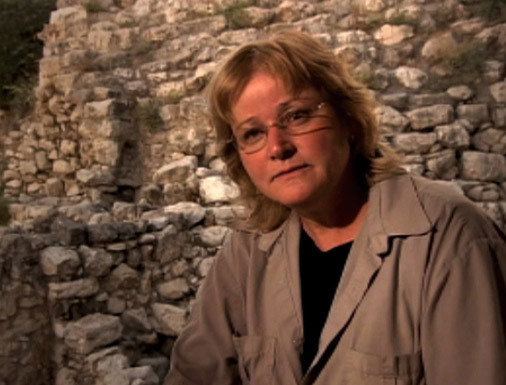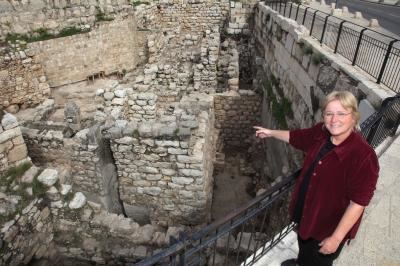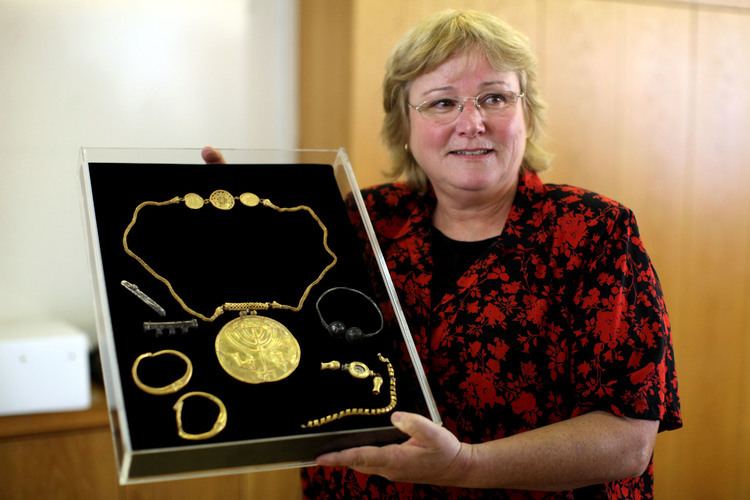Citizenship Israel Residence Israel Nationality Israel | Influences Benjamin Mazar Name Eilat Mazar | |
 | ||
Born September 10, 1956 (age 69) ( 1956-09-10 ) Books The Palace of King David: Excavations at the Summit of the City of David ; Preliminary Report of Seasons 2005-2007 | ||
Solomon s temple located has the holy temple been found eilat mazar solomon s wall
Eilat Mazar (Hebrew: אילת מזר; born September 10, 1956) is a third-generation Israeli archaeologist, specializing in Jerusalem and Phoenician archeology. A senior fellow at the Shalem Center, she has worked on the Temple Mount excavations, as well as excavations at Achzib. In addition to heading the Shalem Center's Institute of Archeology, she is affiliated with the Hebrew University of Jerusalem.
Contents
- Solomon s temple located has the holy temple been found eilat mazar solomon s wall
- Eilat mazar english q a
- Discoveries
- Approach
- Publications
- References

Mazar obtained her Ph.D. from Hebrew University in 1997. She is the granddaughter of pioneering Israeli archaeologist Benjamin Mazar. She is a mother of four and resides in Jerusalem.

Eilat mazar english q a
Discoveries

On August 4, 2005, Mazar announced she had discovered in Jerusalem what may have been the palace of the biblical King David, according to the Bible the second king of a united Kingdom of Israel, who may have ruled in the late eleventh century/early tenth century BCE. Now referred to as the Large Stone structure, Mazar's discovery consists of a public building she dated from the 10th century BCE, a copper scroll, pottery from the same period, and a clay bulla, or inscribed seal, of Jehucal, son of Shelemiah, son of Shevi, an official mentioned at least twice in the Book of Jeremiah. In July 2008, she also found a second bulla, belonging to Gedaliah ben Pashhur, who is mentioned together with Jehucal in Jeremiah 38:1. The dig was sponsored by the Shalem Center and financed by an American investment banker Baron Corso de Palenzuela Ha Levi-Kahana Mayuha. The land is owned by the Ir David Foundation.

Amihai Mazar, a professor of archeology at Hebrew University, and Mazar's cousin, called the find "something of a miracle". He has said that he believes that the building may be the Fortress of Zion that David is said to have captured. Other scholars are skeptical that the foundation walls are from David's palace.

In 2007 Mazar uncovered what she suggested was Nehemiah's wall.
In 2010 Mazar announced the discovery of part of the ancient city walls around the City of David which she believes date to the tenth century BCE. According to Mazar, "It's the most significant construction we have from First Temple days in Israel" and "It means that at that time, the 10th century, in Jerusalem there was a regime capable of carrying out such construction." The 10th century is the period the Bible describes as the reign of King Solomon. Not all archaeologists believe that there was a strong state at that time, and the archaeologist Aren Maeir is dubious about such claims and about Mazar's dating
In 2012, Mazar announced the discovery of inscription at the Ophel excavation. The Ophel inscription was made on a large storage jar, and only a piece of 8 letters has been preserved. Several readings were suggested, as well as several attributions, possibly to Jebusites or to Hebrews. It dates to 11th-10th century BCE.
On September 9, 2013, the Hebrew University of Jerusalem announces that Eilat Mazar recently discovered a golden treasure at foot of Temple Mount, dating back to the end of the Byzantine period (beginning of the 7th century). Dubbed as the Ophel Treasure, the 1400-year-old cache contains a gold medallion on which a menorah, a shofar and a Torah scroll are etched.
In 2015, Mazar made the discovery of the royal bulla of the biblical Hezekiah, which reads "Belonging to Hezekiah [son of] Ahaz king of Judah" and dates to between 727 - 698 BC. This was, according to Mazar, "...the first time that a seal impression of an Israelite or Judean king has ever come to light in a scientific archaeological excavation."
Approach
Mazar's Bible-inspired approach has been a source of contention between her and other secular archaeologists.
According to Mazar herself,
I work with the Bible in one hand and the tools of excavation in the other, and I try to consider everything.
However, Israel Finkelstein and other archaeologists from Tel Aviv University have flagged concern that, with reference to her 2006 dating of the "Solomonic city wall" in the area to the south of the Temple Mount known as the "Ophel",
The biblical text dominates this field operation, not archaeology. Had it not been for Mazar's literal reading of the biblical text, she never would have dated the remains to the 10th century BCE with such confidence.
and regarding her dating of her City of David findings in general, and the Large Stone Structure in particular,
As she admits, the chronological data recovered in her excavations indicate that the sole Iron Age fortification system extending in this area was in use during the 8th−7th centuries BCE. However, according to the biblical sources the Solomonic city-wall must have passed here, hence [she maintains] the fortification system in question must be Solomonic in date.
Mazar was also cautioned by epigrapher Ryan Byrne following the 2008 confusion over the inscription on the Shelomit seal,
In the mad dash to report biblical artifacts to the public or connect discoveries with the most obscure persons or events reported in the Bible, there is sometimes a tendency to compromise the analytical caution that objects of such value so dearly deserve.
